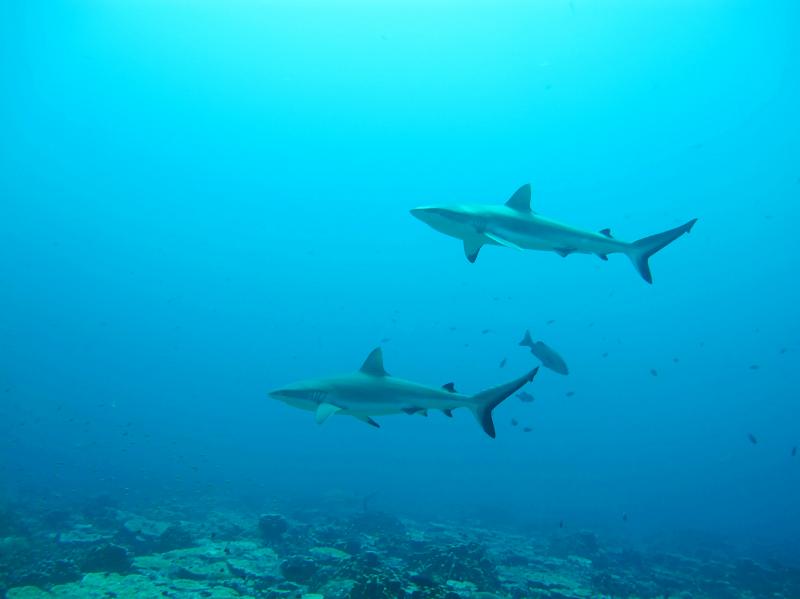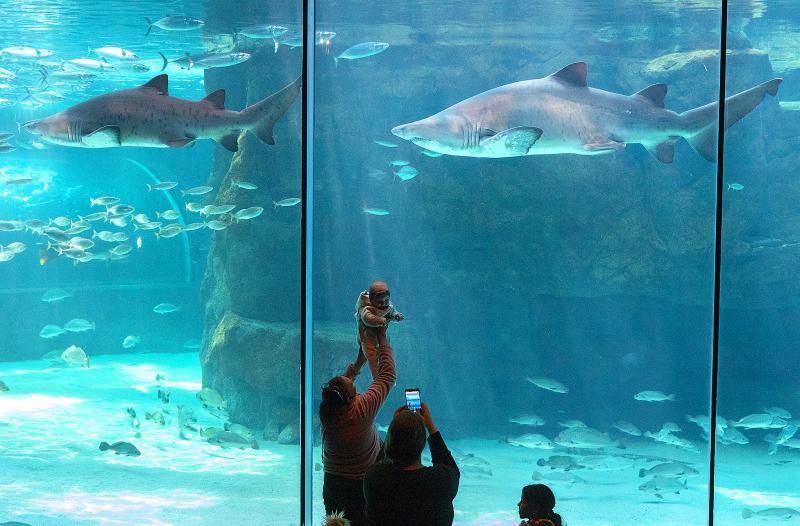The partial skull of an armored fish that swam in the oceans over 400 million years ago could turn the evolutionary history of sharks on its head, researchers have said.
Bony fish, such as salmon and tuna, as well as almost all terrestrial vertebrates, from birds to humans, have skeletons that end up made of bone. However, the skeletons of sharks are made from a softer material called cartilage — even in adults.
Researchers have long explained the difference by suggesting the last common ancestor of all jawed vertebrates had an internal skeleton of cartilage, with bony skeletons emerging after sharks had already evolved. The development was thought so important, living vertebrates are divided into “bony vertebrates” and “cartilaginous vertebrates” as a result.

Photo: Reuters
Among other evidence for the theory, the remains of early fish called placoderms — creatures with bony armor plates that also formed part of the jaws — shows they had internal skeletons made of cartilage.
But now a startling discovery has upended the theory: researchers have found the partial skull-roof and brain case of a placoderm composed of bone.
The fossil, about 410 million years old and reported in the journal Nature Ecology & Evolution, was unearthed in western Mongolia in 2012, and belongs to a placoderm that has been dubbed Minjinia turgenensis and would have been about 20-40cm in length.

Photo: EPA-EFE
“This fossil is probably the most surprising thing I have ever worked on in my career. I never expected to find this,” said Martin Brazeau of Imperial College London and first author of the research.
“We know a lot about [placoderm] anatomy and we have hundreds of different species of these things — and none of them has ever shown this kind of bone.”
The new discovery, he said, casts doubt on the idea that sharks branched off the evolutionary tree of jawed vertebrates before a bony internal skeleton evolved.
“This kind of flips it on its head, because we never expected really for there to be a bony internal skeleton this far down in the evolutionary history of jawed vertebrates,” said Brazeu. “This is the type of thing [which suggests] maybe we need to rethink a lot about how we think all of these different groups evolved.”
While the team say that one possibility is that bony skeletons could have evolved twice — once giving rise to the newly discovered placoderm species and once to the ancestor of all living bony vertebrates — they say a more likely possibility is that an ancestor of sharks and bony vertebrates actually had a bony skeleton, but that at some point in their evolutionary history the ability to make bone was lost in sharks.
Brazeau said the new findings adds weight to the idea that the last common ancestor of all modern jawed vertebrates did not resemble “some kind of weirdo shark” as is often depicted in text books. Instead, he said, such an ancestor more likely resembled a placoderm or primitive bony fish.
Daniel Field, a vertebrate palaeontologist at the University of Cambridge who was not involved in the work, welcomed the findings.
“Evolutionary biologists were long guided by the assumption that the simplest explanation — the one that minimized the number of inferred evolutionary changes — was most likely to be correct. With more information from the fossil record, we are frequently discovering that evolutionary change has proceeded in more complex directions than we had previously assumed,” he said.
“The new work by Brazeau and colleagues suggests that the evolution of the cartilaginous skeleton of sharks and their relatives surprisingly arose from a bony ancestor — adding an extra evolutionary step and illustrating that earlier hypotheses were overly simplistic.”

June 23 to June 29 After capturing the walled city of Hsinchu on June 22, 1895, the Japanese hoped to quickly push south and seize control of Taiwan’s entire west coast — but their advance was stalled for more than a month. Not only did local Hakka fighters continue to cause them headaches, resistance forces even attempted to retake the city three times. “We had planned to occupy Anping (Tainan) and Takao (Kaohsiung) as soon as possible, but ever since we took Hsinchu, nearby bandits proclaiming to be ‘righteous people’ (義民) have been destroying train tracks and electrical cables, and gathering in villages

Dr. Y. Tony Yang, Associate Dean of Health Policy and Population Science at George Washington University, argued last week in a piece for the Taipei Times about former president Ma Ying-jeou (馬英九) leading a student delegation to the People’s Republic of China (PRC) that, “The real question is not whether Ma’s visit helps or hurts Taiwan — it is why Taiwan lacks a sophisticated, multi-track approach to one of the most complex geopolitical relationships in the world” (“Ma’s Visit, DPP’s Blind Spot,” June 18, page 8). Yang contends that the Democratic Progressive Party (DPP) has a blind spot: “By treating any

Swooping low over the banks of a Nile River tributary, an aid flight run by retired American military officers released a stream of food-stuffed sacks over a town emptied by fighting in South Sudan, a country wracked by conflict. Last week’s air drop was the latest in a controversial development — private contracting firms led by former US intelligence officers and military veterans delivering aid to some of the world’s deadliest conflict zones, in operations organized with governments that are combatants in the conflicts. The moves are roiling the global aid community, which warns of a more militarized, politicized and profit-seeking trend

This year will go down in the history books. Taiwan faces enormous turmoil and uncertainty in the coming months. Which political parties are in a good position to handle big changes? All of the main parties are beset with challenges. Taking stock, this column examined the Taiwan People’s Party (TPP) (“Huang Kuo-chang’s choking the life out of the TPP,” May 28, page 12), the Democratic Progressive Party (DPP) (“Challenges amid choppy waters for the DPP,” June 14, page 12) and the Chinese Nationalist Party (KMT) (“KMT struggles to seize opportunities as ‘interesting times’ loom,” June 20, page 11). Times like these can